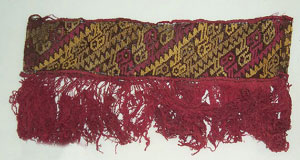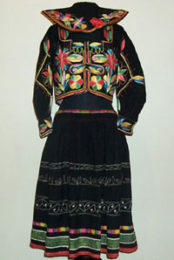Ancient Peruvian textiles showcased in WFU museum exhibit
“Peruvian Textiles, Past & Present” will open at the Wake Forest University Museum of Anthropology April 4. The exhibit runs through Sept. 20 and is free and open to the public.
 The exhibit will feature woven textiles, complete outfits of native clothing and weaving paraphernalia ranging from the second century B.C. to the 20th century, all on loan from local private collections. Ancient cloth, clothing and looms from Chimú, Chancay, Nasca and Inca cultures, on loan from private collectors in New York City as well as Charlotte’s Mint Museum, will also be on display.
The exhibit will feature woven textiles, complete outfits of native clothing and weaving paraphernalia ranging from the second century B.C. to the 20th century, all on loan from local private collections. Ancient cloth, clothing and looms from Chimú, Chancay, Nasca and Inca cultures, on loan from private collectors in New York City as well as Charlotte’s Mint Museum, will also be on display.
The production of fine textiles has been a continuing facet of Andean cultures for the last three millennia and continues to play an important role in Andean societies today. Clothing that many indigenous peoples wear can identify their town of origin. The social status of the wearer, along with gender, age, wealth, power and ethnicity is reflected in colors, fabrics and designs.
A number of events have been planned at the museum in conjunction with the exhibit. All events are free and open to the public, unless otherwise noted.
Keith Richards, assistant professor of romance languages at Wake Forest, will present a public lecture titled “Andean Peoples and Cultures” on April 3 at 7:30 p.m. A reception will follow.
 “Inca Secrets,” a program for children grades 1 – 5, will be presented on April 14 at 4:15 p.m. as a part of the Museum of Anthropology’s ongoing after-school program. The program includes a learning activity and a craft. The cost is $15 per child. Pre-register by April 11 at 336-758-5282.
“Inca Secrets,” a program for children grades 1 – 5, will be presented on April 14 at 4:15 p.m. as a part of the Museum of Anthropology’s ongoing after-school program. The program includes a learning activity and a craft. The cost is $15 per child. Pre-register by April 11 at 336-758-5282.
The video “Traditional Peruvian Weaving: Spinning, Dying and Weaving around Cusco” will be shown May 17, July 12 and Aug.16 at 11 a.m. and 3 p.m.
A public lecture titled “The Shaman’s Tools: Textiles and Natural Objects in the World of an Andean Shaman” will be presented by Joan Parisi Wilcox, author of “Keepers of the Ancient Knowledge: The Mystical World of the Q’ero Indians of Peru,” on June 19 at 7:30 p.m. A book signing will follow.
A public lecture titled “Camels, Cotton and Culture: Textile Traditions of the Ancient Andes” will be presented by Rebecca Stone-Miller, associate professor of art history at Emory University and curator of “art of the ancient Americas,” at the Michael C. Carlos Museum, on Sept. 18 at 7:30 p.m.
“Peruvian Textiles” and associated free programs are made possible in part through the corporate support of David Poythress Designs of Winston-Salem.
Exhibit text and labels will be in both English and Spanish.
The museum is located behind Kentner Stadium on the Wake Forest campus. Regular museum hours are 10 a.m. – 4:30 p.m., Tuesday – Saturday. For more information, call 336-758-5282.
“Peruvian Textiles, Past & Present” Calendar of events
- April 3 at 7:30 p.m.: “Andean Peoples and Cultures,” opening lecture by Keith Richards, assistant professor of Spanish and Latin American Studies at Wake Forest. Reception to follow. Free admission.
- April 4: “Peruvian Textiles, Past & Present” opens. The exhibit showcases woven textiles, complete outfits of native clothing and weaving paraphernalia created in Peru between the second century B.C. and the twentieth century A.D. The exhibit features text and labels in both Spanish and English. Free admission.
- April 14 at 4:15 p.m.: “Inca Secrets,” a program for children grades 1 – 5, will be presented on April 14 at 4:15 p.m. as a part of the Museum of Anthropology’s on-going after-school program. The program includes a learning activity and a craft. The cost is $15 per child. Pre-register by April 11 at 336-758-5282.
- May 24 at 11:00 a.m. and 3:00 p.m.: “Traditional Peruvian Weaving: Spinning, Dying and Weaving around Cusco” video presentation. Peruvian textile traditions dating back thousands of years are still being carried on today. The video visits traditional villages and documents all of the processes involved in textile production. Free admission.
- June 19 at 7:30 p.m.: “The Shaman’s Tools: Textiles and Natural Objects in the World of an Andean Shaman” public lecture and book signing by Joan Parisi Wilcox, author of “Keepers of the Ancient Knowledge: The Mystical World of the Q’ero Indians of Peru,” and the forthcoming “The Healing and Visionary Powers of Ayahuasca.” Wilcox will discuss her training with the shaman-healers of Peru, especially how their sacred cosmology is reflected in their textiles and the natural objects they use in their “medicine bundles.” She will be available after the lecture to sign copies of her book “Keepers of the Ancient Knowledge,” which will be available for sale at the museum shop. Free admission.
- July 12 at 11:00 a.m. and 3:00 p.m.: “Traditional Peruvian Weaving: Spinning, Dying and Weaving around Cusco” video presentation. Peruvian textile traditions dating back thousands of years are still being carried on today. The video visits traditional villages and documents all of the processes involved in textile production. Free admission.
- August 16 at 11:00 a.m. and 3:00 p.m.: “Traditional Peruvian Weaving: Spinning, Dying and Weaving around Cusco” video presentation. Peruvian textile traditions dating back thousands of years are still being carried on today. The video visits traditional villages and documents all of the processes involved in textile production. Free admission.
- September 18 at 7:30 p.m.: “Camels, Cotton and Culture: Textile Traditions of the Ancient Andes” public lecture by Rebecca Stone-Miller, associate professor of art history at Emory University, and curator of “Art of the Ancient Americas,” at the Michael C. Carlos Museum. Stone-Miller will talk about how the dynamic interplay of the Andean environments, the planet’s second highest mountains abutting the world’s driest desert coast and its largest rainforest, had a forceful influence on the values and artistry of this important cultural center. To place into context the exhibition “Peruvian Textiles, Past & Present,” this lecture will explore the ways in which the world around them influenced ancient Andean weavers to create transcendent artworks in fiber over the millennia. Free admission.
Categories: Arts & Culture, Happening at Wake
Media Contact
Wake Forest News
media@wfu.edu
336.758.5237



